We are consistently finding that the places we
explore beat all expectations and there is no better example of that than the
Galapagos. Here we discovered landscapes that are amoung some of the harshest,
most variable and beautiful on the planet; a selection (pun intended) of animal
life that is beautiful to behold and incredible to learn about as they have
defeated so many challenges just to exist. Here we witnessed the same evidence
of evolution upon which Darwin based his work "The Origin of Species".
This post may read a little oddly as Sarah and
I have split the task of narrating our experiences. This post will first
explain some of the history of the Islands and our (human) interaction with
them before exploring our own experiences amount the Islands with particular
references to our wildlife encounters. Please note that we have taken
(especially underwater) a number of videos that have been uploaded to You Tube,
all of them are very short and well worth a quick squiz.
The Galapagos Islands are officially called Archipiélago de Colón and comprise of 18
major islands, 3 smaller islands and 107 rocks and islets that are all entirely
volcanic. They are currently 973km off the coast of Ecuador and as the Nazca
plate moves south east towards the continent of South America the oldest
Islands are to the east of the Archipelago and the newer ones to the west.
They are formed when the hot mantle rises from the core of the earth (much
hotter than the magma immediately below the crust) and actually burns through the
crust to form an underwater volcano that grows until large enough to form an
island. Due to the movement of the plate new islands are constantly being formed
and so we have islands that range in age from 4 million years to as recent as
7,000 thousands years.
The distance from any other landmasses, the
often arid landscapes and the difficult weather patterns mean that it is
extraordinarily tough for land based animals or birds to make the journey
successfully and survive and it is for this reason that there are so few species
on the islands and why those species that have made it adapt to such extremes
that they have become entirely new species, endemic to the islands. While there
is some speculation about how various species made it to Islands a common theory
is that they were blown out to sea on a log or a bed of vegetation and by wind
and current travelled to the islands. This necessarily means that only animals
that are able to survive on little to no food for long periods of time (such as
reptiles) will be able to make it and it is for this reason that the Islands
only have 4 species of land based mammals, excepting those introduced by
humans, and they are 2 species each of bats and rats.
Humans first contact with the Islands is when some South American tribesmen navigated there well before European discovery, however the evidence is not conclusive of permanent settlement as there are no burial sites. The first European contact with the Achipelago was in 1535 when a Panamanian Bishop made landfall due to a lack of winds combined with the southern currents. Between then and the 19th Century the Islands were mostly used by pirates to hide and fight Spanish Galleons returning to Spain from South America. In 1818 a British whaler discovered a large pod sperm whales and on returning to England with his payload prompted large numbers of whalers to pursue their luck in the region. In 1832 Ecuador made its first claim on the Galapagos Islands and sent convicts along with some settlers to start the first town on Floreana. This was the first of many failed attempts by both the Ecuadorian and others who, due to tough conditions, lack of water or in some cases violence failed. Today there are 5 Islands that are inhabited (if you want to know them look them up). Jumping back to 1835 Darwin visits the Islands for five weeks which served as part of his inspiration for "The Origin of Species" published two and a half decades later. Over the next few hundred years the Ecuadorian government attempted to sell or lease the Islands to help its debt issues without success (even though there was alot of interest especially from the Americans) and it was in 1959 when it was final recognised by the government as a tourist destination and named it a national park before starting tourism in 1960.
Enough of history though and onto our own experiences of this natural wonderland...
 |
| We may have borrowed this sign from someone else (hence I'm) |
 |
| Most days we went on day trips like this one to Los Tuneles |
 |
| One of our favourite animals the Marine Iguana |
 |
| It took Sarah a while to work out that "Doble Via" was not an incredible common street name but an indication of a two way road. |
 |
| The Invictus, a boat we sailed on twice to go to Scuba Diving locations |
 |
| Gordon Rocks, one of the world's most popular dive sites |
 |
| Leon Dormido - Sleeping Sea Lion |
 |
| The Fish Market of Santa Cruz where the wildlife often stole some of the days catches |
A 45 and 48kg tuna catch
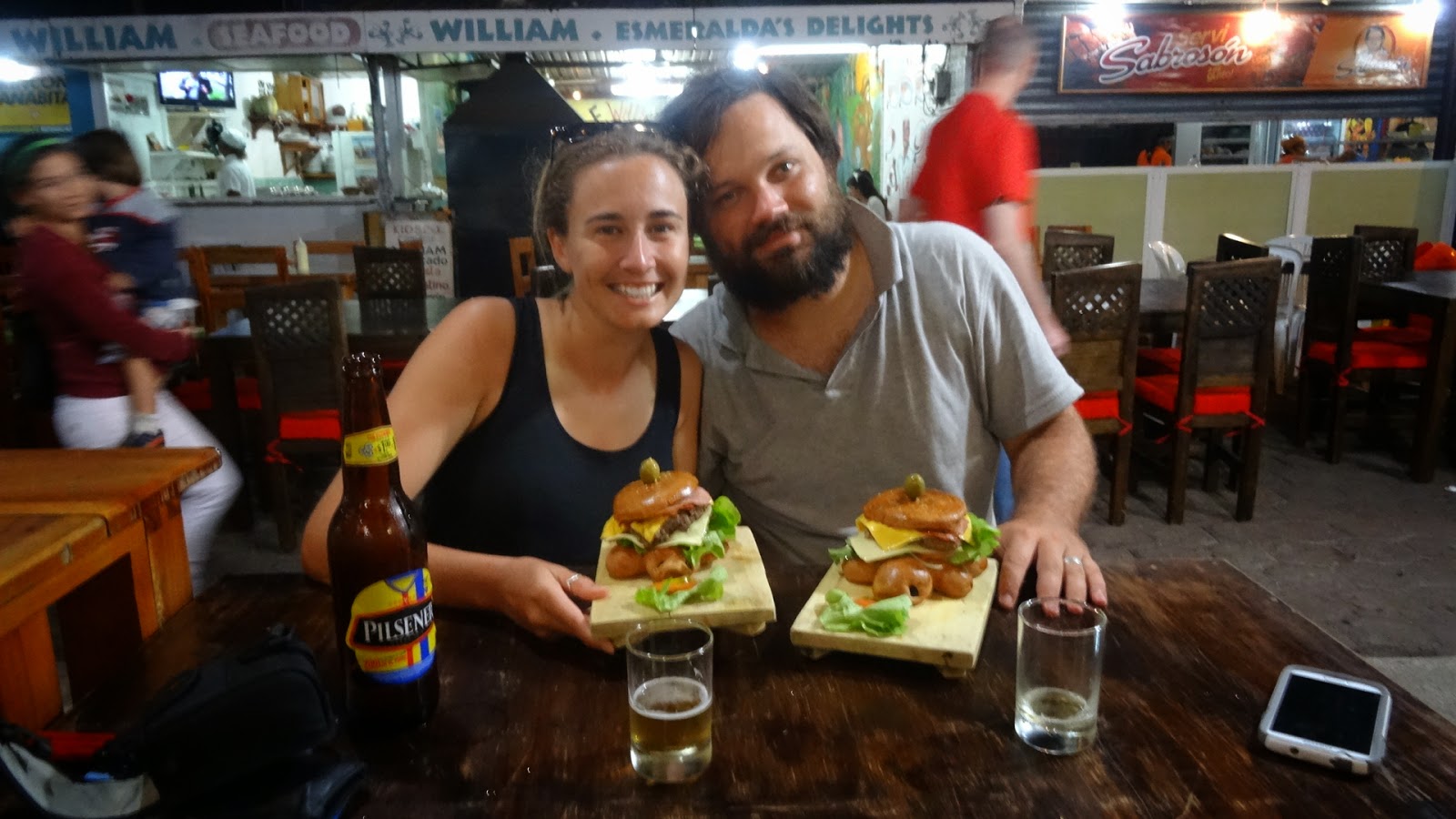 |
| Lonesome George Burgers |
Landscapes
There are many reasons that the Galapagos landscape is so varied, beautiful and challenging and here are some of them:
- The Islands are volcanic and so there are:
- Craters
- Sink Holes
- Lava Tunnels
- Erruptions (although not of the explosive kind)
- LOTS of rock
- Rain is scarce as the Islands often are not tall enough to push clouds high to drop rain so moisture in the air can be the only source of fresh water for plants and animals, so the landscape is broadly divided into four ecosystems (not all are present on every island):
- Arid lowlands and open forests of catci
- Subtropical Forest
- Moist, dense Forest and
- Bare hardend arid lava
- The errosion of the Islands changes the landscape significantly but also the Islands, once they are no longer being renewed or formed by volcanoes start slowly sinking back into the Ocean under their own weight
 |
| Daphne Major from the air |
 |
| Daphne Major from the sea |
 |
| A sink hole caused by trapped gases |
 |
| Lava Tunnels often collapsed |
 |
| A slightly bigger sink hole |
 |
| Gordon Rocks |
Kicker Rock
San Christobal Island
Gordon RocksSanta Fe
Cerro Brujo Beach, San Christobal
Las Tortugas, Santa Cruz
Los Tuneles, Isabela
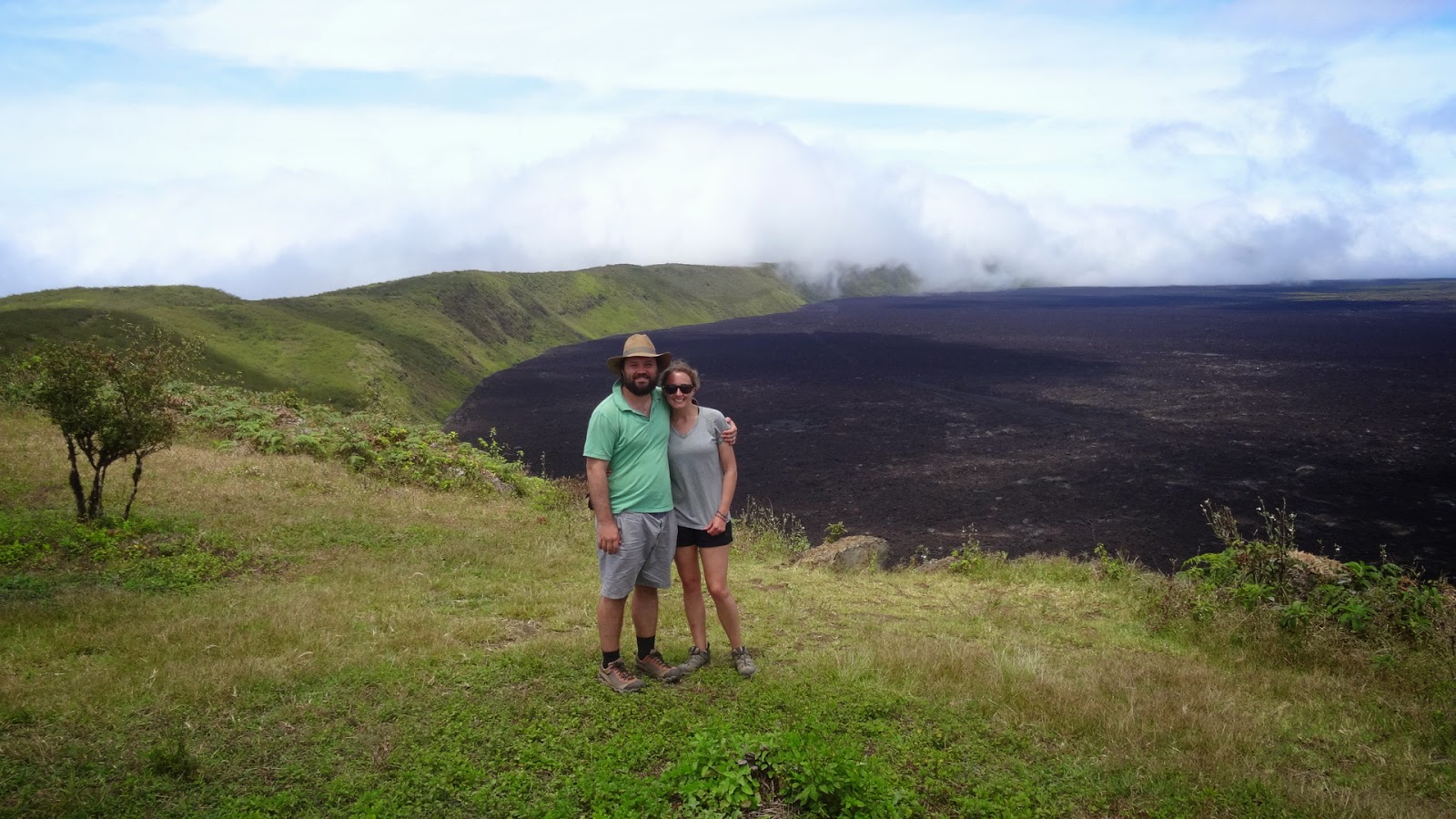 |
| Sierra Negra the second largest active volcano in the world - a crater 10km in diameter and 2km deep |
 |
| The far side of Sierra Negra that does not get the benefit of rain and it shows... |
 |
| Roger - this is what happens if you don't know where the mooring is... |
Land Animals
Giant Tortoises are only found in two places in the world: Seychelles (an island off the Eastern coast of Africa) and the Galapagos, so it was pretty special to be able to get up close with these guys! We saw them in the wild on Santa Cruz Island where they migrate to the middle of the island into the ´scalesia zone´ where vegetation is abundant. There were about 30 or so in a local man´s backyard just chilling and eating grass. For the record, they are huge- measuring 1.5m in length and weighing up to 150kg! They look so ancient and do everything so slowly. They were a bit shy when we got close, retreating their long necks into their shell and making a Darth Vader sound with their breathing! They are not really sure how long they can live because scientists have only studied them for 50 years, but they estimate a life expectancy of 150+!! I couldn´t help but to wonder what these guys would say if they could talk. In the 17th, 18th and 19th century the population of giant tortoises was nearly wiped out by pirates and whalers who killed an estimated 100,000. Tortoises were very valuable as they could live for up to a year without food and water so they would capture hundreds of them, turn them on their backs so they couldn´t escape and in return they would have months of fresh meat and oil. Populations were also threatened by non-native feral species such as pigs, dogs, rats, cats and goats who eat their eggs and food supply. They now have very successful breeding programs on three of the islands which we visited and populations are getting stronger, with an estimated 15,000 individuals.
Some more Giant Tortoise Facts:
-
The Glapagagos Islands were named after the giant tortoises! The word ´Galapagos´ is an old Spanish Word for ´saddle´ which refers to the shape of their shell.
-
There were 15 different sub-species of Galapagos Giant Tortoise when Darwin arrived (now 11) and they are an excellent example of adaptive evolution- The shells of the tortoises living on low lying islands have a more defined saddle shape that allows them to reach up high to feed on vegetation whereas the species on the higher islands have a dome shaped shell as there was plenty of suitable food.
-
Their shells are made of keratin and you can count the rings on the shell to determine the age of a young tortoises (similar to a tree, each ring represents one year). We saw a saw looking one and counted that it was 21years old. When the tortoises have finished growing they lose their rings.
-
Males are larger than females with a curved under-shell so the female shell can fit underneath nicely. The male also has a larger tail for holding on during mating (see video!)
-
A friend I made from the WWF Mexico told us that they have really slow metabolisms and they predict that might be why they can live so long.
-
They nap approx. 16 hours per day.
-
Lonesome George (1910-2012) was a male Pinta Island tortoise who was the last of his sub-species and whose story has inspired many conservation efforts. A guide we met explained to us that it is posible the George is perhaps not so lonesome- they have recently found he shared DNA with some tortoises on Isabela. It remained a mystery why until the Captains Log of Comodor Porter revealed that while chasing British whalers around the islands they would drop tortoises taken aboard for food to lighten the ship! This is the only plausible explanation for how subspecies separated by geological barriers are now living in the same area. He also told us how Lonesome George has one final hope of passing on DNA- even though he passed away two years ago, the sperm remains viable for up to five years, so hopefully one of the two females he shared a pen with at the breeding centre becomes pregnant.
The Glapagagos Islands were named after the giant tortoises! The word ´Galapagos´ is an old Spanish Word for ´saddle´ which refers to the shape of their shell.
There were 15 different sub-species of Galapagos Giant Tortoise when Darwin arrived (now 11) and they are an excellent example of adaptive evolution- The shells of the tortoises living on low lying islands have a more defined saddle shape that allows them to reach up high to feed on vegetation whereas the species on the higher islands have a dome shaped shell as there was plenty of suitable food.
Their shells are made of keratin and you can count the rings on the shell to determine the age of a young tortoises (similar to a tree, each ring represents one year). We saw a saw looking one and counted that it was 21years old. When the tortoises have finished growing they lose their rings.
Males are larger than females with a curved under-shell so the female shell can fit underneath nicely. The male also has a larger tail for holding on during mating (see video!)
A friend I made from the WWF Mexico told us that they have really slow metabolisms and they predict that might be why they can live so long.
They nap approx. 16 hours per day.
Lonesome George (1910-2012) was a male Pinta Island tortoise who was the last of his sub-species and whose story has inspired many conservation efforts. A guide we met explained to us that it is posible the George is perhaps not so lonesome- they have recently found he shared DNA with some tortoises on Isabela. It remained a mystery why until the Captains Log of Comodor Porter revealed that while chasing British whalers around the islands they would drop tortoises taken aboard for food to lighten the ship! This is the only plausible explanation for how subspecies separated by geological barriers are now living in the same area. He also told us how Lonesome George has one final hope of passing on DNA- even though he passed away two years ago, the sperm remains viable for up to five years, so hopefully one of the two females he shared a pen with at the breeding centre becomes pregnant.
baby at the breeding centre
The Great Escape
Land Iguanas
Slightly larger than their cousins the Marine Iguana growing to almost 1m and 13kg they are roughly equal in laziness. The number of these golden lizards has diminished from the point of being a hindrance to the setting up of tents (Darwin's complaint) to under 10,000 due to introduced species eating their young or destroying their habitat. Thankfully they should be safe with a succesful breeding program seeing hundreds returned to their original habitat.
Crabs
The marine iguanas share their seaside lava rocks with hundreds of crabs. The Sally Lightfooted Crab is the most abundant and striking. Whilst they start out life with black shells so they can camouflage well whilst their shells are soft, the adults have spectacular colouration! We also saw the agile ghost crabs scurrying across the sand at Cerro Bujo, a San Christobal beach (see video).
Marine Animals
Sea lions
There are sea lions everywhere you go- they estimate that there are about 50,000 throughout the archipelago! They can be seen sleeping on sandy beachs/boats/rocks/park benches and performing backflips in the ocean. They are so curious and friendly and we spent hours and hours swimming, snorkelling and diving with them. They will literally come right up to you and want to play. They really are the Labradors of the ocean and they often made me think of Fraggle as they gnawed on sticks, spun in circles and stared at you with their big doe eyes if you ever stopped playing. They were definitely one of my favourite animals we encountered.
Green Sea Turtles
“Cause we were like, ‘woaaaah,’ and I was like, ‘woaaaah.’ and you were like, ‘woaaahh…’” I think they hit the nail on the head when they created Crush in Finding Nemo- they are so chilled out and so cool!!! I have always loved turtles and it was so magic to swim with these fellas. I think saw at least one every time we got in the water and they were just mesmerising to watch as they glided by. The first time we swam with them was at Tintoreras and it was really sunny so you could see so many different colours in their shell and skin- just magic! It was also really cool to watch them feed on algae in-between waves off a beach on Floriana Island. The Galapagos Islands are the most important nesting site in the Eastern Pacific for this threatened species and I don´t think there are many places in the world that you can see them in such abundance.
Marine Iguanas
Whilst Charles Darwin had written in his notes that were hideous looking and disgusting clumsy lizards we thought they were nothing short of incredible and they were Ged´s favourite animal. We had watched them with fascination on David Attenbourgh but in the flesh they were even better! We saw them on every island we visited often basking their ectothermic bodies in the sun on the hot volcanic rocks. The first time we saw them at Tortuga Bay on Santa Cruz we thought that there was nothing on the rocks but when we looked closer the rocks were swarming with the creatures, they camouflage so well! Whilst they are incredibly awkward and slow on land they are much better at swimming which we observed at Tintoreras on Isabela Island. They are graceful and fast swimmers (see video!) using their flat tail as a rudder (similar to a crocodile!). I also saw one feeding at Pinzon Island, it was squashing its face against a rock underwater and using its sharp teeth to scape of the algae! It was a short-lived event but really cool
Here is a list of why we thought the Marine Iguanas were so badass:
- They are the only lizards in the world that have the ability to live and forage in the sea.
- They look fierce with slits for a nose and wide-set eyes on their smashed-in face. Their skin is constantly peeling and they´ve got spikes and sharp claws!
- They snot-rocket salt. A nasal gland filters their blood for excess salt ingested whilst eating which is expelled through their nostrils often leaving white patches of salt on their heads/faces.
- They can dive up to 9m and stay underwater for up to an hour!
- They are primarily black so they can rapidly absorb heat after swimming but some of the males are more colourful during the mating season.
- They can absorb their own bones! They can change their size to adapt to varying food conditions for example during an El Nino cycle when food diminishes some were found to decrease their length by as much as 20% and when food returned to normal the iguanas size follows suit.

Penguins
The Galapagos Penguin is the only penguin that lives north of the equator in the wild!! It can survive there due to the cold Humboldt and Cromwell Currents. They are such playful animals and we had fun swimming with them just offshore on both Isabela and Floriana islands (see video!). They are the endangered with an estimated 1500 individuals, making them the rarest penguin in the world. They are also the second smallest species are ridiculously cute.
Sharks, Whales, Fish and others
Sharks
There are four species of shark that we were lucky enough to see in the Galapagos and all of them interesting for their own reasons.
Hammerhead Shark
Always a favourite with divers (everyone we spoke to hoped to see these guys) and rightly so. We did not get to see them very closely but what we saw was cool enough! These bosses of the ocean are cool for a number of different reasons:
- They look cool.
- They heads have ridiculously accurate and sensitive receptors
- Their eyes give them 360 degrees of vision in the vertical plane (but can't see in front of their nose)
- They often form groups during the day sometimes over 100
- They ook cool!
White Tipped Reef Sharks
We got the closest to these guys as they prefer the shallower waters that contain the smal reef fish that make up the majority of their diet. For the most part they sleep during the day as they prefer to hunt at night when they use their super sensitive sensors to detect and catch reef fish as they hide. These guys are a bit unique from other sharks as they do not require forward motion to collect oxygen from the water, they are able to push water over their gills and so can lie in a cave for hours without movement.
Black Tipped Reef Sharks
We only saw these guys once quite briefly swimming. They look awesome as well, but we as they are less common our guides were less forthcoming.
Galapagos Shark
We only saw one of these as it came close the surface near a boat we were on, however we know they are pretty bad-ass as they are a close relative of our own Great White shark.
Humpback Whales
We were lucky enough to be in the Galápagos when the humpback whales are around. After a 7000km journey from Antarctica they arrive in Ecuadorian waters between June and October to reproduce. Off Isabela Island our speed boat driver took us on a whale chase and it was cool to see it breeching a couple of times. Our $20 binoculars purchased proved to be a great investment and we spent an hour or so watching one play off the coast of San Cristobal.
Fish
Reef fish in the crystal clear waters of Tintoreras
Scuba diving with thousands of fish
 |
| Yellow tailed damsel fish |
 |
| Panamic Seargent Major |
 |
| Moorish idol |
 |
| White tailed damsel |
 |
| Look closely - Scorpion fish |
 |
| King angelfish |
 |
| Blue striped snapper |
 |
| Lizard fish |
 |
| Mexican hogfish |
 |
| Bluechin parrotfish |
 |
| Yellow tailed surgeon fish |
 |
| Bicolour parrotfish |
 |
| Harlequin wrasse |
Barracudda
Yellow striped snapper
 |
| Guinea fowl puffer fish |
 |
| Spot-fin porcupine fish |
 |
| Lobster thingy |
 |
| Flag cabrilla |
Red Lipped Batfish
This is another ´only in the Galapagos´ creature! With its unusual morphology and bright red lips it is really bizarre looking. They are terrible swimmers as they are negatively bouyant and instead they use their highly adapted pectorial fins to ´walk´ on the ocean floor at depths of 30m or more. Sightings of this fish are rare and we were really lucky to see three, especially because we only dived to a depth of 20m. Their awkward movability made capturing them easy though and we got some great shots! Check out the vid.
Pacific Seahorse
Rays
We saw four different kinds of rays on our expeditions:
-
Manta Rays- They are majestic giants with their wing span reaching up to 7m. They are filter-feeders gulping large amounts of water, keeping the plankton and spitting out the rest. We caught glimpses of these beauties on our dives at Mosquera, Gordon Rocks and Floreana but none of them hung around very long. On the speedboat off Isabela we also saw a few mating and a few breeching- it was pretty cool to watch them leap completely out of the water! No one can really explain this behaviour, they think it might be curiousity, communication o others of their own species, a desire to rid parasites or maybe they are just playing.
-
Spotted Eagle Ray- striking to look at and often found in reefs or bays, we spotted a baby one at Los Tuneles and I followed it for a while (see vid)
-
Golden Rays- Range in size but always less than 1m and golden in colour. They are usually solitary but in lagoons they swim in large schools and this is exactly how we saw them. There were about 20 swimming together in Los Tuneles and it was pretty epic! Got a great video of them!
-
Sting Ray- grey, boring and common in relation to the others.
Manta Rays- They are majestic giants with their wing span reaching up to 7m. They are filter-feeders gulping large amounts of water, keeping the plankton and spitting out the rest. We caught glimpses of these beauties on our dives at Mosquera, Gordon Rocks and Floreana but none of them hung around very long. On the speedboat off Isabela we also saw a few mating and a few breeching- it was pretty cool to watch them leap completely out of the water! No one can really explain this behaviour, they think it might be curiousity, communication o others of their own species, a desire to rid parasites or maybe they are just playing.
Spotted Eagle Ray- striking to look at and often found in reefs or bays, we spotted a baby one at Los Tuneles and I followed it for a while (see vid)
Golden Rays- Range in size but always less than 1m and golden in colour. They are usually solitary but in lagoons they swim in large schools and this is exactly how we saw them. There were about 20 swimming together in Los Tuneles and it was pretty epic! Got a great video of them!
Sting Ray- grey, boring and common in relation to the others.









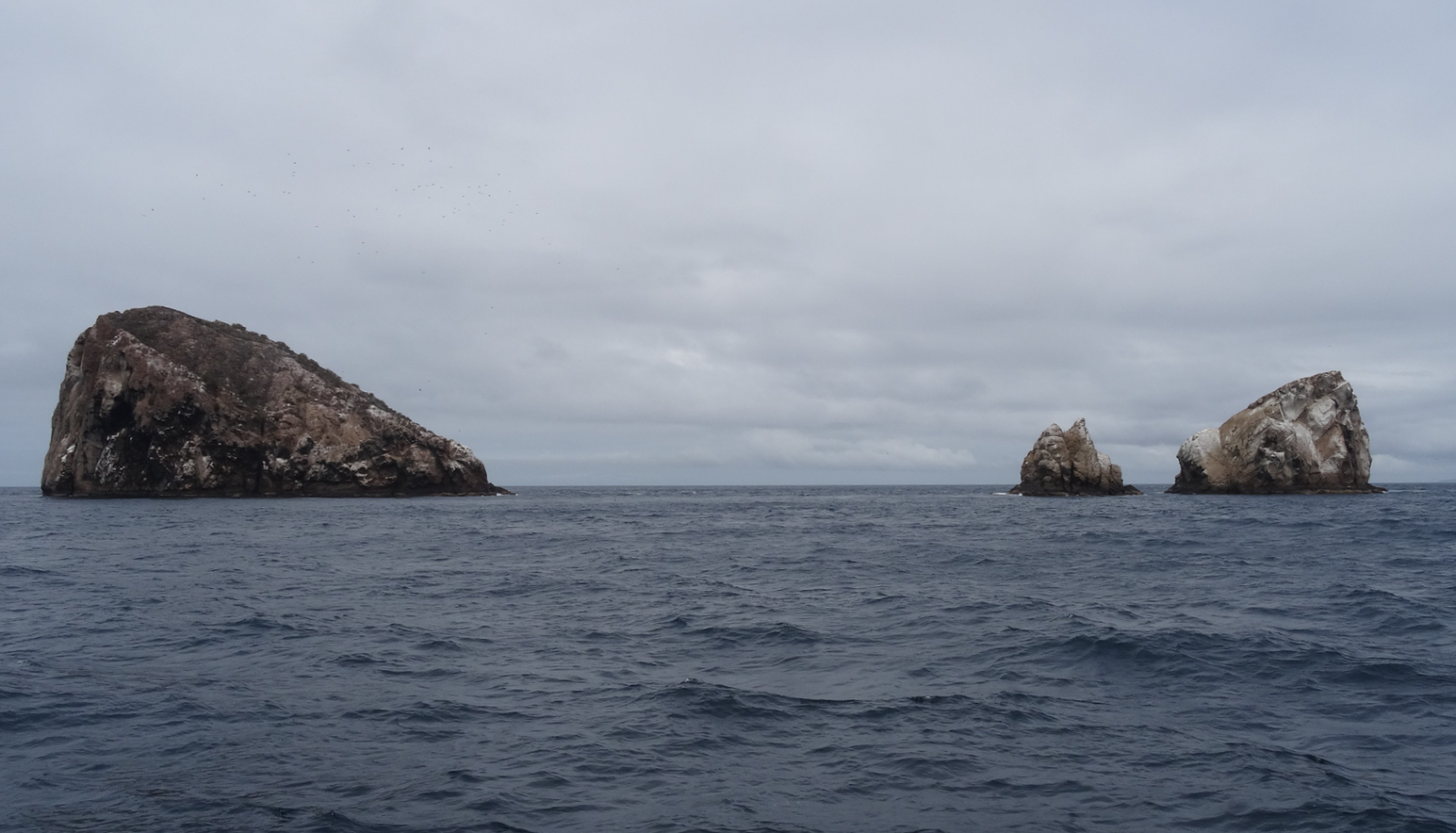





































































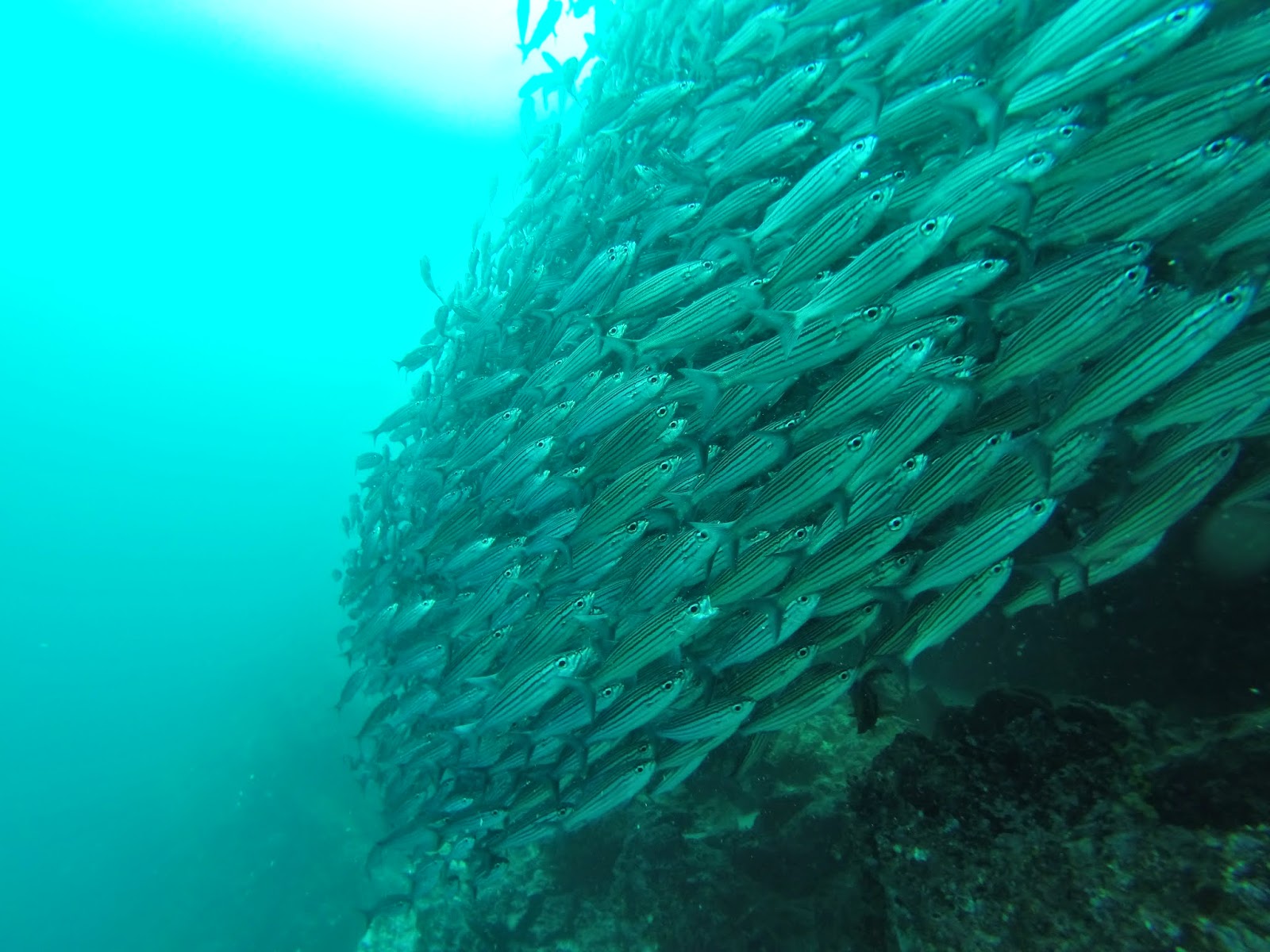




















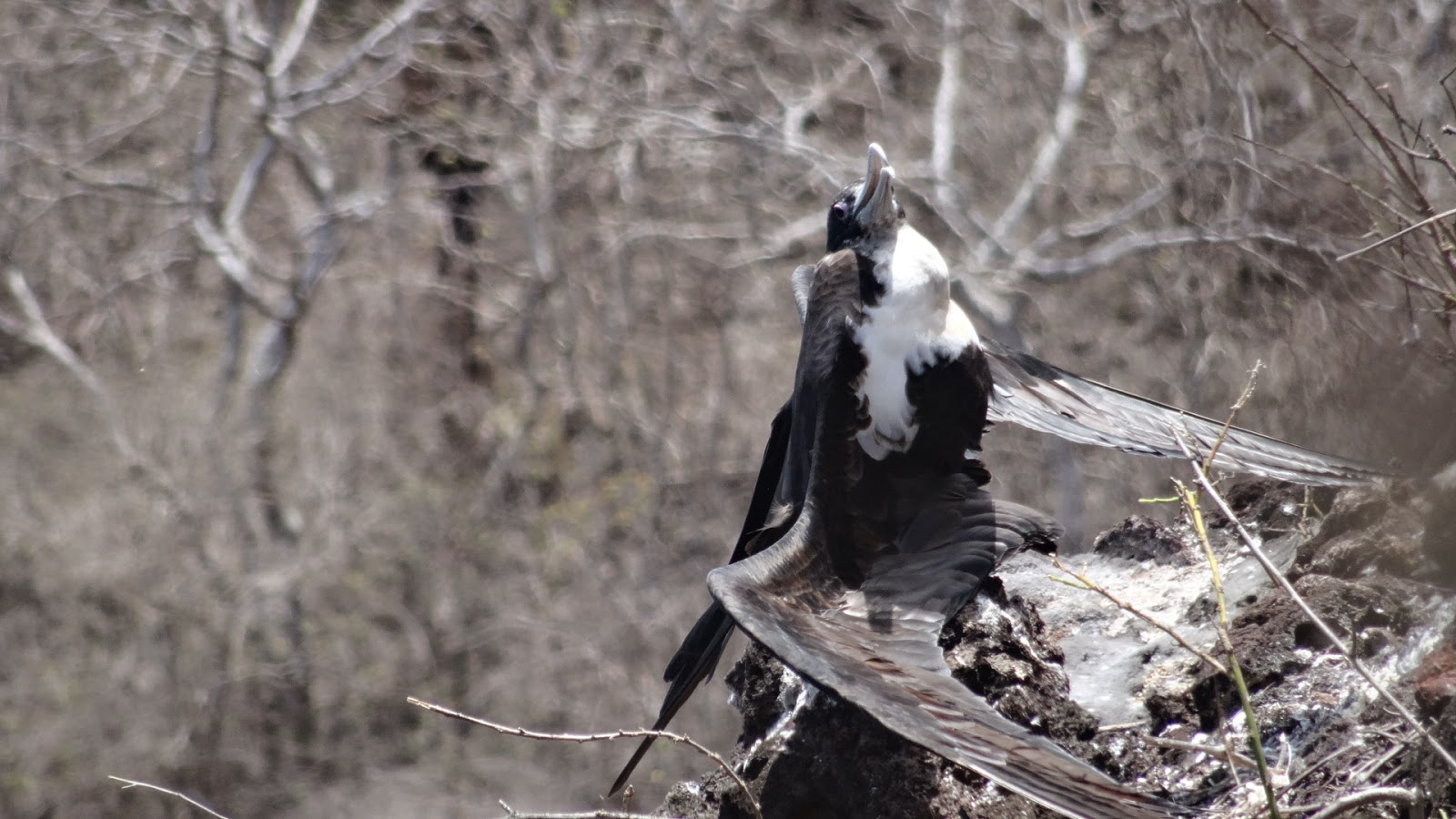

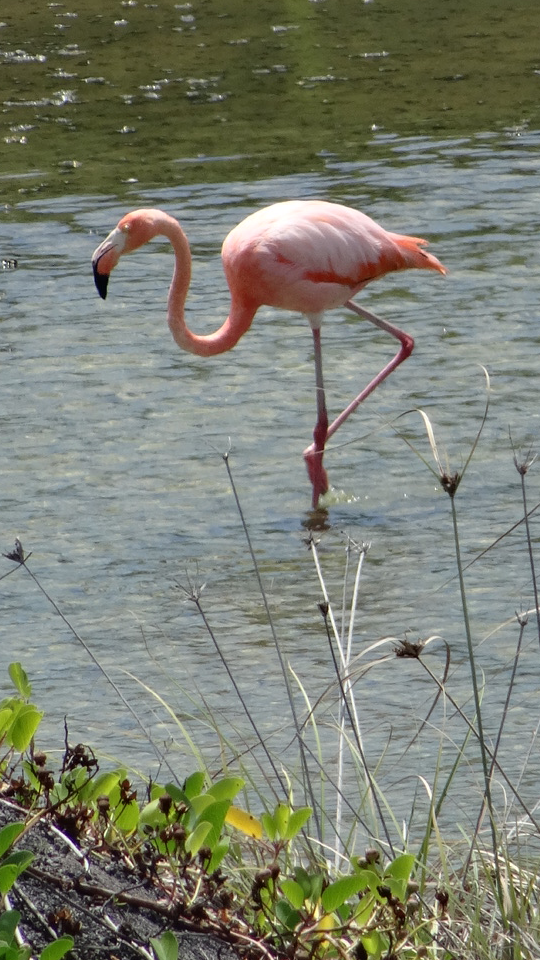





No comments:
Post a Comment